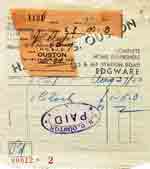Furniture and furnishing prices 1938-1940s in SE England

Furniture receipts and other documents from 1938 to 1940 show prices and descriptions of new furniture and furnishings for a typical 1930s semi-detached house. The page includes photos, and the prices provide evidence of inflation.
____
By the webmaster, based original family documents and inputs from others
In July 1938 my parents married and set up home in a semi-detached house on the northern edge of London's suburbia. The house was empty and needed furniture and general furnishings. Whereas many such houses would have been largely furnished from hand-me-downs, this was not an option for my father, and he had to buy new.
Furniture receipt for descriptions and prices
The following image is of a receipt from 1938 for a number of items of furniture. You can either click the thumbnail to read it or read the transcription underneath. Jaco was short for Jacobean, the wood that was my mother's preference.
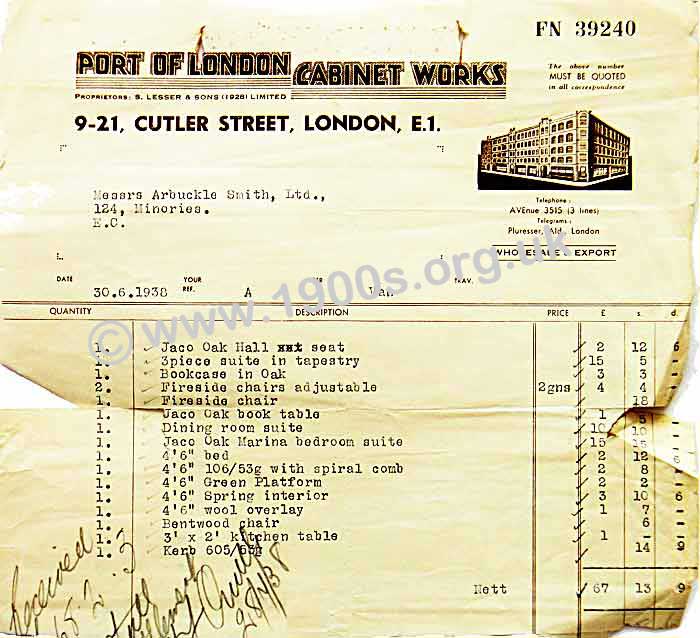
| TRANSCRIPTION OF RECEIPT | |
| Jaco oak hall seat | £ 2-12-6 |
| 3 piece suit in tapestry | £15- 5-0 |
| Bookcase in oak | £ 3- 3-0 |
| Fireside chairs @ 2gns | £ 4- 4-0 |
| Fireside chair | 18-0 |
| Jaco oak book table | £ 1-15-0 |
| Dining room suite | £10-10-0 |
| Jaco bedroom suite | £15-15-0 |
| 4'6" bed | £ 2-12-6 |
| 4'6" 106/53g with spiral comb | £ 2- 8-0 |
| 4'6" green platform | £ 2- 2-0 |
| 4'6" spring interior | £ 3-10-6 |
| 4'6" wool overlay | £ 1- 7-0 |
| Bentwood chair | 6-0 |
| 3'2" kitchen table | £ 1- 0-0 |
| Kerb | 14-9 |
| TOTAL £67-13-9 | |
Incidentally the correctly added up total is not £67-13-9. Tap/clicking the image of the receipt to magnify it shows that the discrepancy was noticed a few months later, presumably in an audit, because in handwriting underneath is:
Received £68.2.3
Apparently not everyone in times gone by was excellent at mental arithmetic!
Furniture description
The description of the items and my own recollections show two main modern furniture styles at the time. All the furniture was solid wood, rather than today's veneered cheaper pine.
One style was medium oak, as shown in the following two photos which are from my parents' home.
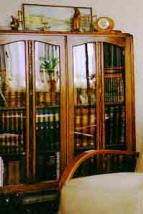
The bookcase that cost £3-3-0 in 1938.

Chair from the three-piece suit that cost £15-5-0 in 1938. Note the washable chairback to save grease marks from men's hair.
The other style, which was my mother's preference was for dark, varnished oak, known then as Jacobean or just Jaco. Legs were always twisted as shown below. The following photos show the Jacobean style.
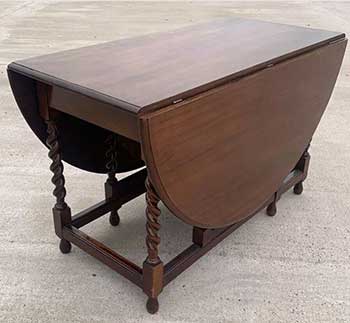
Jacobean folding gateleg table, price unknown.
Note the
dark wood and twisted legs.
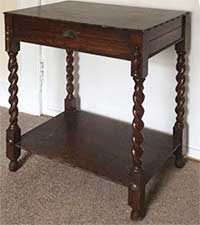
Jacobean oak book table that cost £ 1-15-0 in 1938.
Miscellaneous newly bought modern items
I can make sense of most of the items listed. The kitchen table I remember as white wood which had to be scrubbed with a scrubbing brush just as my mother's mother used to do. (Some years later in the 1950s it was covered with a plastic laminate.)
The 'bentwood' chair was a bedroom chair, and the kerb went round the hearth of the coal fire to keep in the dirt.
Yet I am at a loss to understand the miscellaneous bed items - the spiral comb and the green platform.
Cost of a carved oak wall clock
In 1940 that my mother bought one of her most prized possessions - again from the local furniture shop, Oustons. It was a carved wooden wall clock which another receipt shows as costing £1-5-0. She said that when Mr Ouston came to hang the clock, he said that if it he had seen it in place he would have charged more. Apparently the clock was made by his father or grandfather. World War Two must have already started, and Oustons shortly closed down.
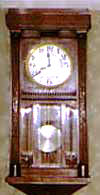
Carved wooden wall clock that cost
£1-5-0 in 1940
Richard Ouston recently contacted me via this website, and I was delighted to donate the clock back to the family.
The receipt is on professionally printed paper and the cost is handwritten. It is almost certainly a carbon copy as carbon copies were always dark blue writing.
Cost of sheets/ bed linen
In 1940 my parents had to buy some more sheets for their bed. Probably they had been existing on hand-me-downs or sheets given as wedding presents. It was the local Oustons' shop that my parents patronised.
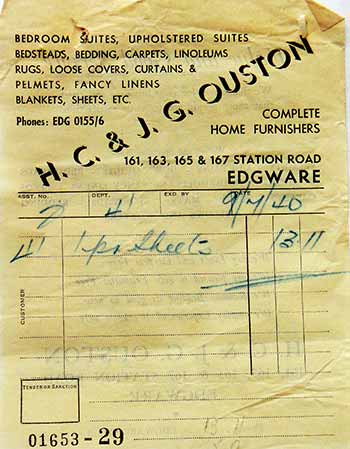
Receipt for a pair of sheets dated 9th July 1940.
The receipt shows that a pair of double sheets cost less than a pound - 13s/11d. This was almost certainly at pre-war prices from pre-war stock. Knowing my father, the sheets were probably linen rather than cotton, and certainly not man-made fibres which had not yet been invented for the mass market.
The sheets must have been double ones as my parents had a double bed and I was only a baby in a cot at the time. The fact that they were sold as a pair reflects the fact that beds were always made up with a bottom sheet, a top sheet, blankets and possibly an eiderdown. Duvets were unheard of at the time among ordinary people.
The receipt is on professionally printed paper and the cost is handwritten. It appears that it is a carbon copy, as print on carbon copies was always dark blue.
Estimating inflation
The receipts and estimates are a resource for considering rates of inflation between then and now. I say 'considering' not 'calculating' because production methods and materials have changed so much over the years.
Also, the receipt for the clock cannot realistically be used to estimate the rate of inflation for this type of work between 1940 and the present day because the clock was hand-carved from solid wood. It was not mass produced from cheap wood with a laminated finish. Nevertheless it serves to show how times have changed. But fancy such a clock now being sold for just over a pound!
Note that the listed prices were pre-war, i.e. before the onset of World War Two. Although some of the items were purchased during the war in 1940, they were probably from stock. The real impact of the war was yet to hit.
All the documents are in the old £-s-d currency, but money has devalued so much that realistically only the pounds are significant today. The number of shillings indicate the fraction of a pound, where there were 20 shillings to a pound. A guinea was £1-1-0 and gns was short for guineas. Guineas rather than pounds were used to imply superior quality, and accordingly professional fees were generally quoted in guineas.
| sources | webmaster | contact |
Text and images are copyright
If you can add anything to this page or provide a photo, please contact me.


